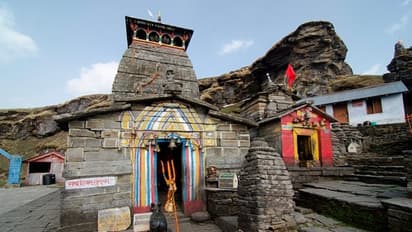Tungnath, world's highest Shiva temple in Uttarakhand, faces water leakage, weakening foundation

Synopsis
Tungnath Temple, the highest temple dedicated to Lord Shiva, is facing severe structural issues that threaten its safety and stability. Located at an altitude of 3,680 metres in Uttarakhand's Rudraprayag district, the temple has experienced increased water leakage, subsidence, and a weakening foundation, particularly during the recent monsoon season.
Tungnath, the world's highest temple dedicated to Lord Shiva, perched majestically at a soaring altitude of 3,680 meters in Uttarakhand’s Rudraprayag district, is grappling with grave structural issues. The temple, revered for its ancient origins, is now facing the peril of water seepage, subsidence, and a crumbling foundation—issues that have drastically worsened under the relentless onslaught of monsoon rains.
This escalating damage has raised serious concerns about the temple’s stability, posing a potential threat to the safety of the thousands of devotees and tourists who visit the sacred site each year.
Legend has it that this sacred temple was built by the Pandavas from the epic Mahabharata following the legendary war of Kurukshetra, adding to its cultural and religious significance. However, the centuries-old structure now finds itself in dire need of preservation.
Taking swift action, the Badrinath Kedarnath Temple Committee, under the leadership of Ajendra Ajay, has reached out to the Geological Survey of India (GSI) and the Archaeological Survey of India (ASI) for expertise on possible restoration solutions. Responding to the call, both agencies dispatched expert teams to survey the temple in September. After a detailed inspection, they laid out their recommendations on how to mitigate further deterioration of the ancient structure.
Ajendra Ajay voiced his concerns, stating, "The temple is facing serious issues like subsidence, weakening foundation, and shifting wall slates, which have caused water leakage, especially during the rainy season." In a bid to safeguard the sacred site, the committee has also sought assistance from the Central Building Research Institute (CBRI) to ensure comprehensive safety measures.
Though the temple is not officially protected by the ASI, Manoj Saxena, superintendent archaeologist at ASI, told The Times of India (TOI), "While the temple is not officially protected by ASI, our team visited the site and gave our recommendations. Now it is up to the temple committee and the Uttarakhand govt to take the necessary actions."
Uttarakhand's tourism minister, Satpal Maharaj, acknowledged the gravity of the situation, remarking, "Given the temple's water leakage and structural problems, the govt is prioritising its repair to ensure the structure remains safe for all visitors."
Stay updated with the Breaking News Today and Latest News from across India and around the world. Get real-time updates, in-depth analysis, and comprehensive coverage of India News, World News, Indian Defence News, Kerala News, and Karnataka News. From politics to current affairs, follow every major story as it unfolds. Get real-time updates from IMD on major cities weather forecasts, including Rain alerts, Cyclone warnings, and temperature trends. Download the Asianet News Official App from the Android Play Store and iPhone App Store for accurate and timely news updates anytime, anywhere.